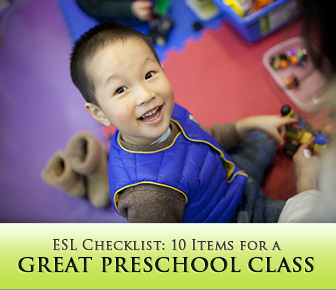ESL Checklist: 10 Items for a Great Preschool Class


Preschool is so much fun. It can be difficult to teach a second language to children still trying to grasp their own and who cannot yet read. It can also be really enjoyable because these students have the flexibility to learn languages more quickly and are usually very enthusiastic.
Activities
Keep everything as simple and short as possible. These students do not have long attention spans and are easily distracted so you should try to be the most interesting thing in the room at all times. Students may also have a hard time sitting still during class so plan activities that let them move around. Simon Says is excellent for preschoolers. You can also have them make groups with the same number of people as the number you say aloud so if you say “Four” students have to make groups of four. This is another very fun, fast moving, and active game. With decks of vocabulary cards that have pictures instead of words, students can play simple games in small groups. A very basic game is to spread the cards face up and the first student to slap the correct card when you call out a word gets to keep it; the student with the most cards at the end of the game wins. You can also conduct some team based activities such as Chinese Whispers, which encourages students to be quiet and patient.
Songs/Gestures
Students at this age do well with songs and gestures. You can have songs for each part of the day to help them learn and remember certain vocabulary for instance, a morning song might include getting up, brushing teeth, and eating breakfast. You can also use songs in your lessons for speaking practice since it is less intimidating to sing-a-long with the class than to speak individually. You should create gestures for different words because this will make it easier for students to remember new vocabulary. Choose gestures that you are comfortable with and that are simple enough for you to do repeatedly throughout the course. Teaching preschoolers requires a high energy level and you may feel silly at first but these students can be a real pleasure to work with and they will certainly appreciate your efforts.
Worksheets
Worksheets for this age group are less common. Unlike worksheets used for older students, preschool worksheets do not need to have any words on them. In most cases worksheets for this age level should not have words on them at all however it will depend on your school. Either way, you can still use worksheets to practice material and test comprehension, for example, you can ask students to draw a picture while you tell a story. The story would be have to be very short and simple but if you tell a story about a tree and a student draws a house then it might be time to get those flashcards out again. You can also use coloring pages and do matching activities where you ask students to match the pictures of two words you say aloud. This also serves as a simple comprehension test.
Stories
While your students will not be reading much in your class, they may enjoy hearing some stories especially if the lesson is during a quieter part of their day. The best stories for this age group, regardless of the activity you have in mind, are repetitive. This ensures that students catch the main points. Stories such as Goldilocks and the Three Bears and One Fish, Two Fish, Red Fish, Blue Fish might be appropriate for your students at this level. If students have heard the story more than once, you can ask them to tell you the story based on the illustrations. Students often enjoy this type of activity in their native language so you may as well include it in your lessons. Start with the most basic story you can find to see if your class enjoys having story time.
You can usually cover topics such as body parts, colors, numbers, weather, emotions, appearance, and routines. You will have to introduce new vocabulary slowly and do lots of practice activities each day. Every lesson should be focused on speaking, listening, and having fun.